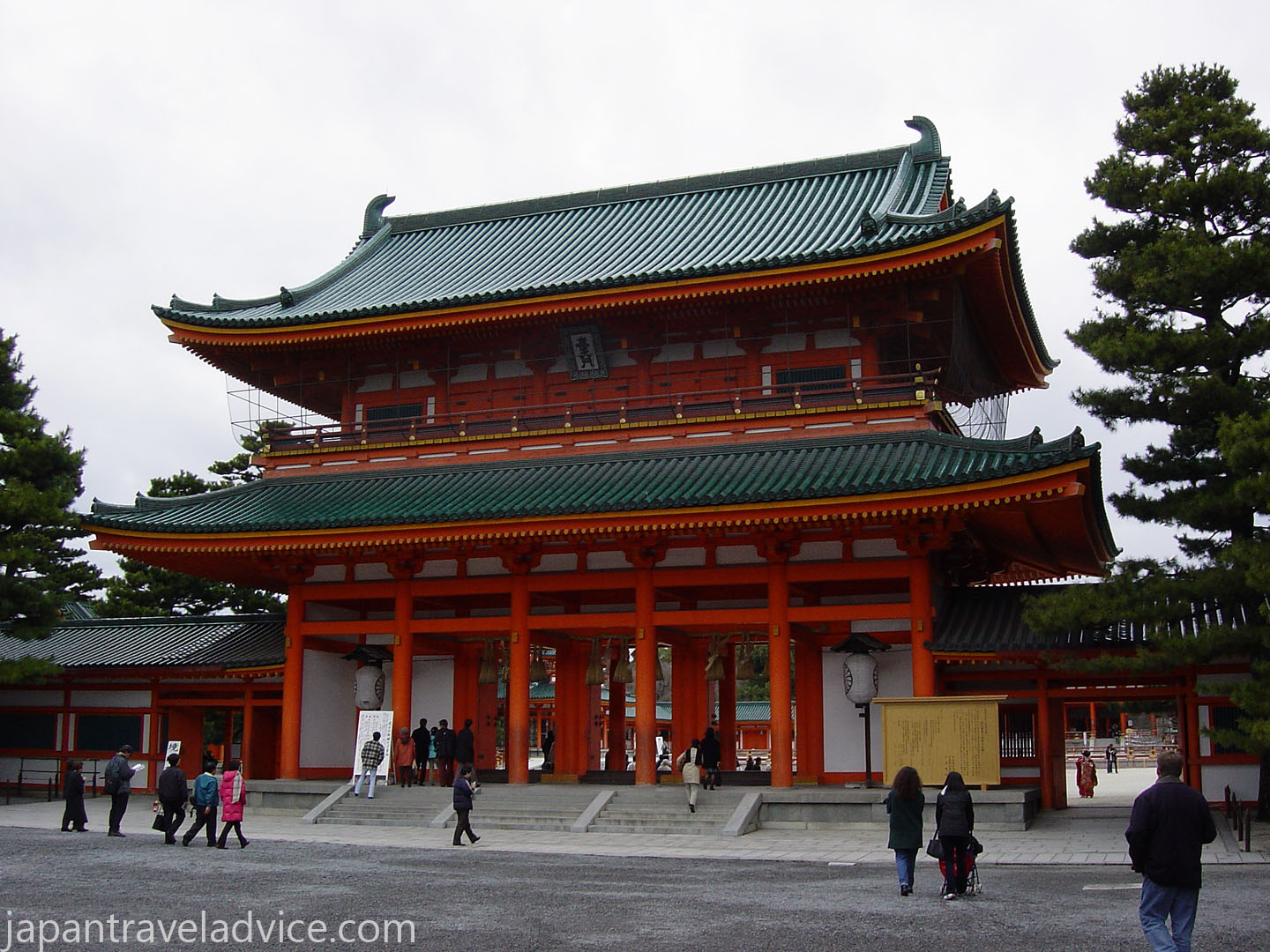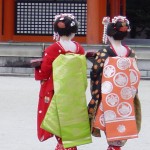
Heian Jingu Shrine has a short history but is still considered a must see attraction in Kyoto. It is a rarity as a modern shrine in Kyoto, which is famous for its shrines, which are hundreds of years old. It was built in 1895 to commemorate the 1100th anniversary of the founding of Kyoto. Heian-kyo was the former name of Kyoto and the shrine is dedicated to the first and last emperors, who reigned from Kyoto. The current buildings are replicas of the original Kyoto Imperial Palace which was destroyed in 1227, and is two-thirds the size of the Kyoto Gosho of the Heian period (794-1185). It is a fantastic example of how significant Chinese influences were during the Heian period in Japan.
A giant tori gate about 500 meters in front of the shrine marks the entrance. It is one of the largest in Japan at 24.2 meters high.
What to See at Heian Jingu Shrine
Heian Jingu Shrine Daigoku-den Great Hall of State
The first thing that strikes you about Heian Jingu Shrine is the vast amount of space. It is very spacious with a wide open courtyard at the center. The colours of the buildings also stand out in orange, green and white. The Daigoku-den, built in 1894, is the largest building and is the main hall of the shrine. Daigoku-den was the Great Hall of State at the original Kyoto Imperial Palace (Daidairi).

Heian Jingu Shrine Main Gate Oten-mon
The Oten-mon gate at Heian Jingu Shrine was built in 1894 and is two storeys high. It is a reproduction of the original gate at the Kyoto Imperial Palace (Daidairi).

Heian Jingu Shrine Soryu-ro
The Soryu-ro, also known as the Blue Dragon tower is the East Tower beside Daigoku-en. It was built in 1894 and is two storeys high. It is a classic example of the Chinese style of architecture with white walls, vermillion lacquered pillars and wood trim and green tiled roof.

Heian Jingu Shrine Gaku-den
The Gaku-den was built in 1940. I was lucky to spot a couple of maiko here during my visit.


Heian Jingu Shrine Garden
The garden located behind the main buildings is amazing and very spacious with a large pond and Chinese inspired bridge. The garden was built to represent the style of garden that was popular during the Heian period. The garden contains many cherry trees, which make it a popular spot for cherry blossom viewing in Kyoto.
The Shrine is surrounded by Japanese stroll gardens on three sides of the shrine. The Minami Shin-en (South Garden) on the west side, Nishi Shin-en (West Garden) on the north-west side, Naka Shin-en (Middle Garden) on the north east side, and Higashi Shin-en (East Garden) on the east.
Special Events
Heian Jingu Shrine holds two major events during the year
• Jidai Matsuri (Festival of the Ages) held on 22 October to celebrate the founding of Kyoto
• Takigi No Performances held from 1 to 2 June
History of Heian Jingu Shrine
Heian Jingu Shrine was built in 1895 to commemorate the 1100th anniversary of the founding of Heian-kyo (Kyoto). The shrine is dedicated to two emperors: Kammu (737-806) who founded Kyoto in 794 and Komei (1831-1866) who was the last emperor to reign in Kyoto before the capital moved to Tokyo.
The building of the shrine helped revitalize Kyoto, which stagnated after the capital was moved to Tokyo.
Opening Hours
Heian Jingu Shrine is open from
6.00 am to 6:00 pm from 15 March to 31 August
6:00 am to 5:30 pm from September, October, early March
6:00 am to 5:00 pm from November to February
The Gardens are open from
8.30 am to 5:00 pm from 15 March to 31 August
8:30 am to 5:00 pm from September, October, early March
8:30 am to 4:30 pm from November to February
Entry Fee
Admission to the shrine precinct is free
Admission to the Garden is 600 yen for adults and 300 yen for children
How to Get There
You can reach Heian Jingu Shrine by taking bus No 5 or No 100 from JR Kyoto Station or Keihan Sanjo Station to the Kyoto Kaikan Bijutsu-kan mae bus stop. It takes about 30 minutes and costs 220 yen. You can also walk from Keihan Sanjo Station which is around 15 minutes. Alternatively, take the Tozai subway line to Higashiyama Station, where it’s a 10 minute walk to the shrine.
Address: Okazakinishi Tenno-cho, Kyoto
Best Time to Go
Heian Jingu Shrine can be visited all year round, but the Gardens are at their most beautiful during spring and autumn. It is a popular cherry blossom spot in Kyoto during the spring with its weeping cherry trees at their best in April. Summer is a great time to see the irises and water lilies, while autumn is beautiful with the changing Japanese maple leaves in late November.
Tip: Check out Nanzen-ji, which is one of the best temples in Kyoto with expansive grounds and sub-temples. It is about a 20 minute walk from Heian Jingu Shrine.
Photo Gallery
Things to Do in Kyoto
- Kiyomizu-dera Temple – One of the most famous landmarks in Kyoto and a UNESCO World Heritage Site
- KInkakuji Temple – Temple of the Golden Pavilion and a UNESCO World Heritage Site
- Nijo Castle – Built as the official Kyoto residence of the Shogun and a UNESCO World Heritage Site






